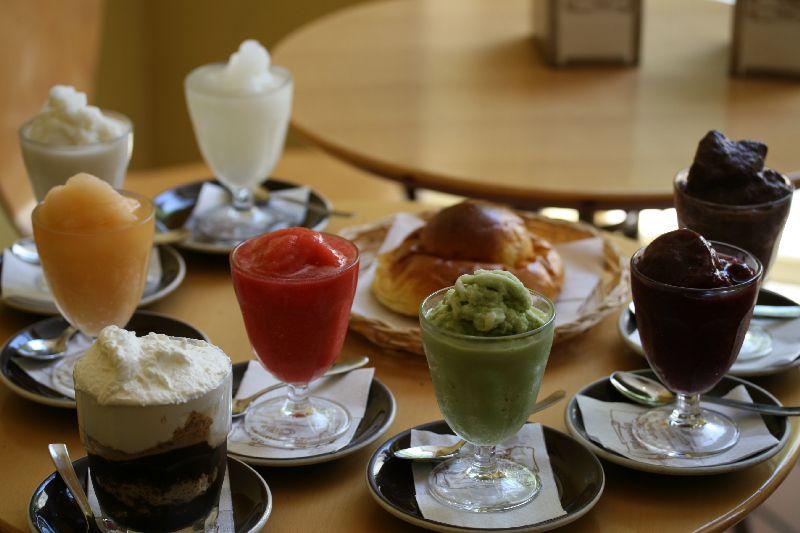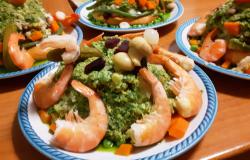But my eyes are drawn away from greenery and water onto a mound of soft, leaf-thin slices of veal carpaccio, surrounded by rosettes of near-transparent carrot slices and topped by a shiny white sauce with just a hint of Gorgonzola—enough to tease the palate but not overpower the meat.
For me, nothing says summer more than fresh local food—perhaps a fillet of seabass grilled to perfection on a barbecue by the beach, a pile of prawns, pale pink against their bright orange shell, or cream white trofie swimming in a sea of myrtle green pesto—preferably washed down with a glass of dry, aromatic white wine. It is the perfect time to explore new places and new flavours, or cherish old favourites. And there’s no better country to do that than Italy. If I could hop from town to town during the course of a meal, this would be my ideal one:
Starter: Focaccia col Formaggio, Recco
 Caught between the sea and a crown of wooded hills, Recco is a cluster of pastel-coloured houses lining the beach promenade, graceful churches perched high on the hills behind them. But its fame owes more to the focaccia col formaggio than post-war waterside architecture. La focaccia di Recco is a dazzling white core of molten crescenza cheese oozing from two paper-thin sheets of golden dough. Legend wants it to be the bizarre byproduct of centuries of strife. Some say it fortified Ligurian crusaders before they took off to the Holy Land. Others want it born of pirate raids, when the people of Recco fled their seaside town—exposed to the scimitars and guns of invading Saracen corsairs—and took to the hills, where they survived on cheese, oil and flour. One day, some clever housewife—I like to think the original chef was a woman, although of course I have no proof of it—thought of mixing flour, water and oil into dough, filling it with cheese, and baking it on a slab of slate. The combination took off, but, for a time, it was an autumnal dish, served in those misty days of early November when the dead are remembered across Italy. Until the early 20th century and the first tourists arrived, and the crafty cooks of the local trattorie realised they had a winner at their hand. Now it is cooked in a copper pan, and is the queen of the Ligurian summer.
Caught between the sea and a crown of wooded hills, Recco is a cluster of pastel-coloured houses lining the beach promenade, graceful churches perched high on the hills behind them. But its fame owes more to the focaccia col formaggio than post-war waterside architecture. La focaccia di Recco is a dazzling white core of molten crescenza cheese oozing from two paper-thin sheets of golden dough. Legend wants it to be the bizarre byproduct of centuries of strife. Some say it fortified Ligurian crusaders before they took off to the Holy Land. Others want it born of pirate raids, when the people of Recco fled their seaside town—exposed to the scimitars and guns of invading Saracen corsairs—and took to the hills, where they survived on cheese, oil and flour. One day, some clever housewife—I like to think the original chef was a woman, although of course I have no proof of it—thought of mixing flour, water and oil into dough, filling it with cheese, and baking it on a slab of slate. The combination took off, but, for a time, it was an autumnal dish, served in those misty days of early November when the dead are remembered across Italy. Until the early 20th century and the first tourists arrived, and the crafty cooks of the local trattorie realised they had a winner at their hand. Now it is cooked in a copper pan, and is the queen of the Ligurian summer.
Main course: Aragosta alla Catalana, Alghero
 Alguer. Even the name, Italianised into Alghero, holds a mysterious promise in this little corner of Italian Catalunya. Geography and sheer luck made it an outpost of the Aragonese crown during their medieval conquest of Sardinia, and bequeathed it mighty forts and golden walls, slender churches and the musical sounds of a Catalan-infused dialect. And the lobster. Well, that was already swimming in the deep blue seas off the northern Sardinian coast, but the way of cooking it was alla Catalana, Catalan-style. Like the Catalans of yore, it has since colonised the whole of Sardinia, although it remains best in its city of origin. Finely sliced tomatoes and onions cover the boiled lobster, white meat peeking coyly from the crimson shell, in a triumph of whites and reds, made shiny by a generous drizzling of olive oil. It is a rare treat—Sardinian lobsters are vanishing fast, so fishing restrictions apply—that wants a glass of crisp, intense Capichera wine for company.
Alguer. Even the name, Italianised into Alghero, holds a mysterious promise in this little corner of Italian Catalunya. Geography and sheer luck made it an outpost of the Aragonese crown during their medieval conquest of Sardinia, and bequeathed it mighty forts and golden walls, slender churches and the musical sounds of a Catalan-infused dialect. And the lobster. Well, that was already swimming in the deep blue seas off the northern Sardinian coast, but the way of cooking it was alla Catalana, Catalan-style. Like the Catalans of yore, it has since colonised the whole of Sardinia, although it remains best in its city of origin. Finely sliced tomatoes and onions cover the boiled lobster, white meat peeking coyly from the crimson shell, in a triumph of whites and reds, made shiny by a generous drizzling of olive oil. It is a rare treat—Sardinian lobsters are vanishing fast, so fishing restrictions apply—that wants a glass of crisp, intense Capichera wine for company.
Dessert: Granita Siciliana, north-eastern Sicily
 I never knew granita until I set foot in north-eastern Sicily at the grand old age of 18. Oh sure, I had had the odd cupful of crunchy ice crystals, vaguely flavoured with a fast-disappearing syrup, which is called granita in many Italian cafes both in Italy and abroad. But I mean the real thing. The one that thrills the mouth with a fresh zing of lemon, or the powerful hit of coffee. The one whose flavours last long in your throat. The one that is almost thick enough to chew (although it loves the reassuring solidity of a buttery brioche). This I only discovered during that long-gone trip, and I am not ashamed to say it made as lasting an impression as the slim arches and azure vistas of the amphitheatre in Taormina. Granita is good everywhere in Sicily, but best on the north-eastern corner of the island. Taormina and Catania are good for lemon or almond granite. Messina is best for the granita al caffe, served with cream and a brioche. It makes an excellent if unusual breakfast but (sans brioche) I also like it to end a meal instead of a hot espresso.
I never knew granita until I set foot in north-eastern Sicily at the grand old age of 18. Oh sure, I had had the odd cupful of crunchy ice crystals, vaguely flavoured with a fast-disappearing syrup, which is called granita in many Italian cafes both in Italy and abroad. But I mean the real thing. The one that thrills the mouth with a fresh zing of lemon, or the powerful hit of coffee. The one whose flavours last long in your throat. The one that is almost thick enough to chew (although it loves the reassuring solidity of a buttery brioche). This I only discovered during that long-gone trip, and I am not ashamed to say it made as lasting an impression as the slim arches and azure vistas of the amphitheatre in Taormina. Granita is good everywhere in Sicily, but best on the north-eastern corner of the island. Taormina and Catania are good for lemon or almond granite. Messina is best for the granita al caffe, served with cream and a brioche. It makes an excellent if unusual breakfast but (sans brioche) I also like it to end a meal instead of a hot espresso.




